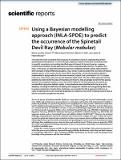Por favor, use este identificador para citar o enlazar a este item:
http://hdl.handle.net/10261/326457COMPARTIR / EXPORTAR:
 SHARE SHARE
 CORE
BASE CORE
BASE
|
|
| Visualizar otros formatos: MARC | Dublin Core | RDF | ORE | MODS | METS | DIDL | DATACITE | |

| Título: | Using a Bayesian modelling approach (INLA‑SPDE) to predict the occurrence of the Spinetail Devil Ray (Mobular mobular) |
Autor: | Lezama-Ochoa, Nerea; Pennino, Maria Grazia CSIC ORCID ; Stewart, J.D.; López, J.; Murua, Hilario | Palabras clave: | Pesquerías INLA Centro Oceanográfico de Murcia |
Fecha de publicación: | 2-nov-2020 | Citación: | Scientific Reports, 10. 2020: 18822-18822 | Resumen: | To protect the most vulnerable marine species it is essential to have an understanding of their spatiotemporal distributions. In recent decades, Bayesian statistics have been successfully used to quantify uncertainty surrounding identified areas of interest for bycatch species. However, conventional simulation-based approaches are often computationally intensive. To address this issue, in this study, an alternative Bayesian approach (Integrated Nested Laplace Approximation with Stochastic Partial Differential Equation, INLA-SPDE) is used to predict the occurrence of Mobula mobular species in the eastern Pacific Ocean (EPO). Specifically, a Generalized Additive Model is implemented to analyze data from the Inter-American Tropical Tuna Commission’s (IATTC) tropical tuna purse-seine fishery observer bycatch database (2005–2015). The INLA-SPDE approach had the potential to predict both the areas of importance in the EPO, that are already known for this species, and the more marginal hotspots, such as the Gulf of California and the Equatorial area which are not identified using other habitat models. Some drawbacks were identified with the INLA-SPDE database, including the difficulties of dealing with categorical variables and triangulating effectively to analyze spatial data. Despite these challenges, we conclude that INLA approach method is an useful complementary and/or alternative approach to traditional ones when modeling bycatch data to inform accurately management decisions. | Versión del editor: | https://www.nature.com/articles/s41598-020-73879-3 | URI: | http://hdl.handle.net/10261/326457 | DOI: | 10.1038/s41598-020-73879-3 | ISSN: | 2045-2322 | Referencias: | https://doi.org/10.1038/s41598-020-73879-3 |
| Aparece en las colecciones: | (IEO) Artículos |
Ficheros en este ítem:
| Fichero | Descripción | Tamaño | Formato | |
|---|---|---|---|---|
| Scientific_Reports_Lezema_2020.pdf | 1,3 MB | Adobe PDF |  Visualizar/Abrir |
CORE Recommender
PubMed Central
Citations
3
checked on 07-abr-2024
SCOPUSTM
Citations
20
checked on 14-may-2024
WEB OF SCIENCETM
Citations
21
checked on 22-feb-2024
Page view(s)
32
checked on 21-may-2024
Download(s)
9
checked on 21-may-2024
Google ScholarTM
Check
Altmetric
Altmetric
Artículos relacionados:
NOTA: Los ítems de Digital.CSIC están protegidos por copyright, con todos los derechos reservados, a menos que se indique lo contrario.
